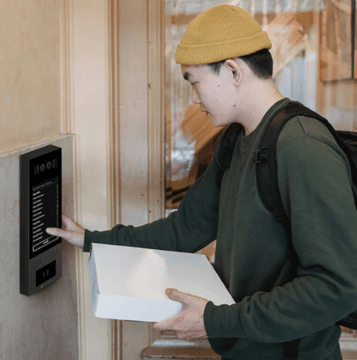If selecting a multi-door access control system is a part of your job description, it’s a responsibility you can’t take lightly. Selecting a system that doesn’t fit your needs is going to increase the operational cost and burden, undermine security, and deteriorate the workplace experience. That’s why we have put together this guide to help you select a system that will not embarrass you when it’s time to scale.
Let’s start!
In this article:
- What are multi door access control systems
- Multi-door vs single door access control systems
- Multi-door access control methods
- Issues in selecting the right multi door system
- Why you should use one system for several doors and buildings
- What can go wrong when you scale access control systems
- Considerations to buying multi door access systems
- How Swiftlane solves the problem of scaling to multiple doors
Suggested Posts:
- Ultimate Guide to Building Intercom Systems
- Access Control Solutions: How to Choose One
- Door Access Control: A Complete Guide
What is Multi Door Access Control?
A multi-door access control system consists of software and peripheral devices that allows you to control multiple doors and access points. Multi-door systems are typically installed in large commercial facilities, multifamily apartment buildings, hotels, hospitals, university campuses, government or public buildings, and other facilities where different levels of access control are required for multiple doors.
Technically speaking, a two-door access control system is also a multi-door system. But for the purpose of this article, we shall call a system multi-door when it can fulfill the access control and security needs of large buildings and enterprises, which may need to connect dozens of doors and potentially several geographically distant buildings to the same system.
Multi Door vs Single Door Access Control
Single-door access control systems are connected to the reader and the door controller on a single door in one location. These systems can often be programmed at the reader itself, by adding card numbers etc to it. Smaller systems may be able to support anywhere between 1 – 4 doors, and provide simple controls for programming access rules into them. Some single-door systems can be scaled to a larger network by using additional components such as wireless IP data bridges or wired technologies like Ethernet or twisted cable.
Multi-door systems have a dedicated software running on a computer on premise, or in the cloud to run configuration for the system. All access points can be centrally controlled and programmed from an on-site computer in case of an on-premise system or from web browsers and mobile apps if it’s a cloud-based system. Multi-door access control systems can secure a variety of access points including entrances, interior doors, gates, cabinets, lockers, server racks, elevators, parkings and garages.
Multi Door Access Control Methods
Different multi-door access control systems can use one or more of the following methods for controlling access through different doors:
Card-Based Access
Key cards are currently the most widely deployed form of access credential. Every card has a unique number programmed into them, and access can be configured for various doors using the same card number. E.g. A visitor’s card can be programmed to access only the front door for one day, whereas an employee’s card may be programmed to access all or specific internal doors permanently. For keycards to be used as multi-door credentials, the access control software must be able support multiple access levels.
Mobile Access
The credential is tied to the user’s mobile phone. You can gain access to a particular door or opening using an access control mobile app (e.g. Swiftlane) that sends the credential to the reader via Bluetooth, NFC or an API call to the cloud.
Biometric Access (Face recognition or fingerprints)
The credential is tied to your biometric identity such as your face, fingerprints, retina, or palm. Biometric credentials cannot get lost or stolen and are permanently associated with the individual, which makes them securer than other types of credentials.
Face recognition access provides a more seamless approach, since you just have to show up in front of the reader and the door unlocks. Fingerprints have lost popularity after COVID-19 since people don’t want to touch the same fingerprint scanner.
PIN Pads
You can also have PIN readers that allow typing a pin to get access. PIN codes are vulnerable to easy sharing and can compromise your security. Care should be taken to give unique PINs to users and change them periodically to avoid leaking access. However, this increases the operational workload.
Browser Access
Users can gain access through a door by clicking a link in their email or browser. Multi door systems use this feature to allow visitor access.
Issues in Selecting A Multi Door Access Control System
The definition of multi-door access control might be simple, but selecting the right multi-door access control for your building is not.
The selection process is complicated by the fact that many modern access control products masquerading as multi-door are designed for very simple deployments at small offices. Their limitations become glaring when you try to scale them beyond a certain limit.
For example, systems like Isonas access control offer single-door reader-controllers that are directly connected to the internet. The software is designed to allow single door access, such that access control is built into the reader. This gives the reader a lot of intelligence so that you don’t need a separate server to manage it. However, you would need to program access for users at each door, since they don’t have centralized access management.
The older on-premise systems offer some flexibility in the sense that they run on a computer in your building, so you can program new access levels, change access permissions, and program cards on site. However, you cannot easily scale them to larger deployments because they’re limited by the processing power of the software. Also, on premise Windows based systems can be very technical and complex to operate.
For example, S2, which is a legacy on-premise system installed at many large establishments, uses Nodes to extend the system to multiple doors. Each Node can support up to 2, 8, or 14 doors, depending on the Node type. Scaling a system like S2 to hundreds of doors could thus require installing dozens of nodes and miles of cabling.
So, what do you do when you need to scale a system that cannot be scaled easily or cost-effectively? Should you let the old system be and get a new, cloud-based system installed for the additional doors or buildings? Or, should you completely replace the old system with a modern alternative?
Why You Should Use One Access Control System for Multiple Doors or Buildings
Sometimes, the expense and trouble of extending a system may force you to drop the idea of scaling the current system and start looking for another, more scalable multi-door solution to manage additional doors or buildings. Using different systems to manage different doors or buildings, however, has its own caveats.
Maintenance Issues
Multi-door access control systems have a large number of components that need regular maintenance. Maintaining two different systems simultaneously might be more difficult for your technical staff than maintaining a single system. The cost and hassle of maintenance are likely to increase if you use different access control systems to manage different facilities or doors
Management Issues
Having a single credential to check into different facilities makes it easy for your office teams to issue, revoke, and track credentials. Different access control systems would have different credentials and would require additional teams for monitoring and managing access.
Training Issues
Multi door access control systems have tons of features. Unless it’s a fully managed Access-Control-as-a-Service (ACaaS) solution you are using, your staff will need training for managing, maintaining, and customizing the system. Using different systems increases the training time and costs and puts more load on your staff.
Data Management and Record-Keeping
Using a single centrally managed system makes it easier to collect, store, and retrieve event data from all doors and buildings. If you have different systems installed in different buildings, the event data can get locked in silos and can be difficult to access.
What Can Go Wrong When You Scale the Access Control System?
Adding more doors to a system that was not designed for large-scale multi-door operation can lead to serious security risks as well as user inconvenience. Here are the top 5 problems you can expect to face when you add multiple doors to a limited-capacity system.
Lack of Multiple Access Levels
Many offices skip the advanced features while buying a card-based access system, considering them to be unnecessary expense. The result is a system with a single default access level that allows any card holder to access any door at any time. You might think one flat configuration is more convenient for users, but one lost or stolen card can compromise the security of the whole system. Therefore, a multi-door access control system should support multiple access levels and schedules.
Tailgating and Piggybacking
Problems such as piggybacking or tailgating are likely to multiply when you add more doors to the access control system. Most single-door access control systems don’t stop these common workplace malpractices. Scaling them is only going to make matters worse.
Compatibility with Locking Hardware
Is your existing access control system compatible with all types of locks including magnetic strike, electrical strike and electric deadbolt? You can run into a big problem if you extend the system to another building and find out the software doesn’t support the locking hardware installed in that building.
Alarm Monitoring
Failure to monitor and respond to event alarms is one of the biggest access-control problems that security teams can face. With more openings added to the system, it’s going to be harder to track and respond to security events like unauthorized entry, door left open, or unexpected guest access.
Extensive Cabling
Typically, with multi door access control systems, you will run cabling between all the doors and some form of an IDF (Intermediate Data Frame), which is connected to the main access control board. The clutter, cost and disturbance associated with laying down new cables can be reduced by using IP based systems that install on existing Ethernet cables.
Considerations for Selecting the Best Multi Door Access Control
Selecting and deploying a multi-door access control application is a business-critical decision you and your tenants or employees are going to live with for years to come. Consider the following factors to select the best system for your facilities.
Size of the Deployment
The scale of your deployment is one of the most important factors to consider. The needs of a small office that has a couple of entries to secure are much different from those of a large enterprise that has to secure hundreds of doors across multiple sites. You can start the evaluation and selection process by conducting a need analysis. Consider the number and types of openings that you need to secure and make sure the hardware is capable of supporting them.
On-Premise Or Cloud Connected?
On-Premise Multi-Door Access Control: On-premise solutions like Tyco Software House and Genetec come with tons of features and extensive programmability. When customized, they can allow you to control exactly who is authorized to use a particular opening at what times. However, programming and maintaining on-site applications can be a sap on your time and resources. You need on-site staff to operate and troubleshoot these systems. They are extremely complex to program and require training to operate and customize.
Cloud Hosted Multi-Door Systems: Modern cloud-based access control systems take the burden of maintenance and customization off your shoulders. Your staff can grant, revoke, and alter access permissions; schedule, check in and monitor visitors; activate remote lock or unlock; and perform many other access management tasks through a user-friendly browser or mobile app interface. Access platforms such as Swiftlane can be scaled horizontally and have the capacity to accommodate a potentially unlimited number of openings and buildings.
Types of Credentials
Key Cards and FOBs: Most host-bound access control systems and many cloud-based solutions have keycards as the primary credential. Cards and FOBs have tons of limitations that make them insecure and unsuitable for multi-door and multi-site operations. Cards do not link the credential to a person’s identity so there’s always a security gap. Lost or stolen cards remain a looming security threat and increase the operation burden of your teams. Card-based systems cannot handle a large number of doors in multiple buildings unless they’re connected to the cloud.
Mobile Credentials: Cloud-based multi-door access control systems often deploy mobile access control, a technology that allows smartphones, tablets, and wearable smart devices to function as a user’s credentials. Mobile access control is more convenient for users and puts an end to the incessant lost-, stolen- or forgotten-card phenomena. Mobile credentials eliminate the need to print and distribute keycards and FOBs, which is a huge financial and operational burden in itself. Your staff can modify access permissions, lock or unlock doors, enroll and remove users, and perform all other access control functions from anywhere using a mobile app or web browser.
Biometric Credentials: Biometric credentials such as facial recognition, fingerprints, or palm scanning can add more security to any multi-door access control application. Swiftlane offers optional built-in facial recognition features in its Swiftreader. Once activated, the feature provides completely automatic touchless access to authorized users. You don’t need to pull out your phone or operate an app to gain entry. Just face the Swiftreader, and the door unlocks.
Ease of Scalability
Most cloud-based access control systems may claim the ability to connect hundreds of doors, but the ease and economy of the scalability are the main questions to ask. For example, a single ACS6000 Series controller on the Brivo Onair platform can support up to 30 doors. So, you should ask the question how multiple controllers will connect with each other and how they will interoperate with other integrated devices like video intercom or electronic door locks.
IP based access control devices like Swiftlane readers and controllers only require Ethernet or Power over Ethernet connections to work, thus eliminating direct wiring between the Swiftreader and access control panels and providing larger ability to scale.
How Swiftlane Solves the Multi Door Problem
Being a cloud-based access control platform, Swiftlane can easily scale to a potentially unlimited number of doors and openings without putting your IT and technical staff under pressure. Swiftlane’s powerful cloud hosted software can be scaled using parallel cloud servers. All you need to do is spell out your requirements, and our engineers will take care of the technicalities.
As for the hardware, Swiftlane’s access control components connect with each other over your existing Cat-5 Ethernet cable network, making installation easier and less costly. The expansion causes minimal disturbance as you don’t need to run electrical wires from each door to the control panel. The user-friendly web interface makes it easy for your security team to add more openings, enroll users, manage access permissions, allow guest access, and secure multiple doors and buildings from a single dashboard.
Think Swiftlane is the right multi-door access control solution for your building? Get in touch with us to get a quote.




